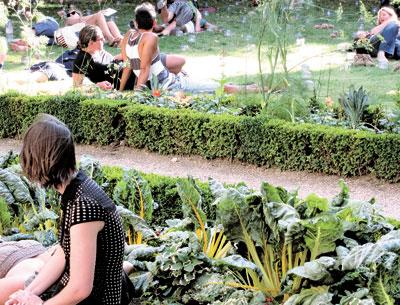Star Gardener: An American Gardener in Paris

Yellow chard, of all things, is the “it” plant in Parisian gardens this year. During a sunny and warm week in early September, the light was at the perfect angle to show off the luminosity of its stems.
Yellow chard was the star of gardens from a small, well-used and loved neighborhood park in the Marais to potagers in an interior courtyard in the 16th century Hotel de Carnavalet, and in an extravaganza of urban agriculture at the renowned Bagatelle Gardens in the Bois de Boulogne.
Parisian gardens have taken up the American and British locavore, or home-grown produce, movement, but add unique fillips. Who else but the French would think of combining red-flowered strawberry plants with red roses and mulch? The strawberries were flowering and fruiting at the same time as the prospect of a bountiful autumn harvest. The wholesaler Monrovia, in this country, lists Lipstick, a very showy, easy strawberry groundcover with bright red flowers and shiny fruit.
Amusing, stylish scarecrows, wandering peacocks, and topiaries of chickens at the Bagatelle might be adaptable in our gardens. Combinations of herbs and vegetables with ornamentals are not strangers here, but in Parisian public gardens are mainstream.
During the last 20 years the French have become much more focused on flowers, and some of the best new plants in our gardens come from French hybridizers. Yes, the allées of trees and formal parterres are still there, but at the Luxembourg Garden you almost don’t notice them because of the exuberance of a deep perennial border, natural plantings of grasses that soften statuary, and a spectacular edging of red and yellow zinnias without a spot of mildew.
The entrance to the Quai Branley Museum, designed by the superstar architect Jean Nouvel and completed six years ago, is through a very large wild garden. It is certainly not a prairie garden or “new American” garden, but there is a whiff of influence. What is odd is that both the entrance garden and the celebrated Patrick Blanc vertical garden (Mur Vegetal) on the riverside facade of the museum obscure the exterior architecture.
Only an artist supremely confident in his ability would be so bold.
My familiarity with the often-photographed vertical garden was no preparation for viewing it in person. Relying on drip irrigation, I doubt that it is ecologically green, but no matter: The mosaic of perennials, grasses, and ferns is a tour de force of texture in all the variants of green. In the United States, such vertical gardens are mostly found inside in commercial spaces or the homes of intrepid, adventurous gardeners. The LongHouse Reserve in East Hampton had entries in vertical gardening in its On and Off the Ground exhibition for the last two years, although with varying degrees of success.
Who knew that before the High Line in New York City was even a twinkle in anyone’s eye, it was a fait accomplis in Paris? It opened 20 years ago on a nearly three-mile stretch of an abandoned elevated railway beginning just behind the new Opera Bastille. Called the Promenade Plantée (tree-lined walkway), the gardens have a feeling of shaded tranquillity and maturity, and are well-integrated into the surroundings. The arches of the former railway viaduct were renovated and are used as workshops and shops for highly skilled artisans.
Nearly every open space in Paris is planted with perennials, trees, and shrubs: even the facade above the sign of the famous Cafe de Flore. And lights are in gardens as well. One small garden in the Marais is dotted with solar lights set in the ground that twinkle at night, creating a veritable performance artwork.
Perhaps Paris should be renamed the City of Lights and Greenery.
Scarecrows are follies in a vegetable garden at the Bagatelle Rose Garden.
Abby Jane Brody
Strawberry blossoms, roses, and mulch in a public vegetable garden.
Abby Jane Brody
Luxuriant perennial borders, here in the Luxembourg Gardens, are new to France.
Abby Jane Brody
Abby Jane Brody
Abby Jane Brody
Abby Jane Brody
Abby Jane Brody
